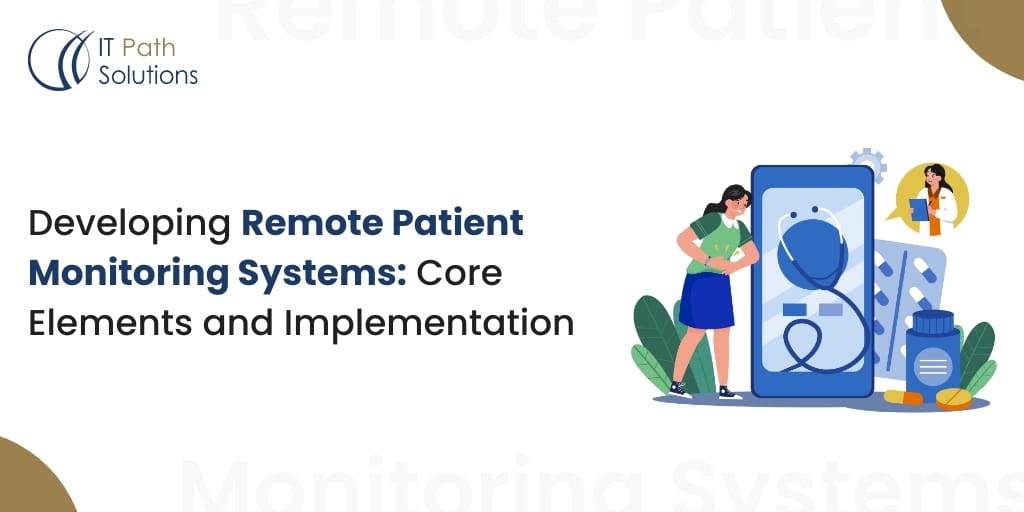Navigating the Complexities of Custom EHR/EMR Development: A Strategic Guide

Are Current EMR/EHR software systems up to the task? Most electronic health record (EHR) and electronic medical record (EMR) systems on the market today still need to be improved. Sure, Healthcare organizations finally started using patient data in the 21st century by digitizing records, but that’s just the bare minimum.
There are no major difference between EHR and EMR systems, An EMR (Electronic Medical Record) is a digital version of a patient’s chart for internal use within a single healthcare provider, while an EHR (Electronic Health Record) is a broader, interoperable record that can be shared across multiple healthcare providers to give a comprehensive view of a patient’s health history.
Core issues that should have been solved a while ago, like seamless record sharing and interoperability between different healthcare providers’ systems, need to be more coherent. Trying to integrate and access a patient’s full medical history across multiple facilities still requires jumping through way too many hoops.
Then there are the high costs involved for any healthcare organization trying to deploy a comprehensive, fully-featured. Telemedicine platform from scratch. We’re talking $50,000 just for a mid-tier system light on advanced capabilities right off the bat. Need enterprise-grade bells and whistles? Be ready to cough up anywhere from a few hundred grand to a staggering $1 million or more. Even basic integration with legacy record systems can run upwards of $100k. That’s an exorbitant toll just to bring your IT up to modern standards.
Challenges and Limitations of Current EMR/EHR Systems
Data sharing issues:
Healthcare providers struggle with incompatible systems, an issue manufacturers are reluctant to tackle. Ideally, merging a patient’s full medical history into one comprehensive overview, irrespective of the IT systems used by different providers, should be straightforward. However, the actual task of enabling communication between various electronic medical record (EMR) databases remains daunting. This is largely because software companies prefer to trap clients within their exclusive ecosystems rather than embracing open standards.
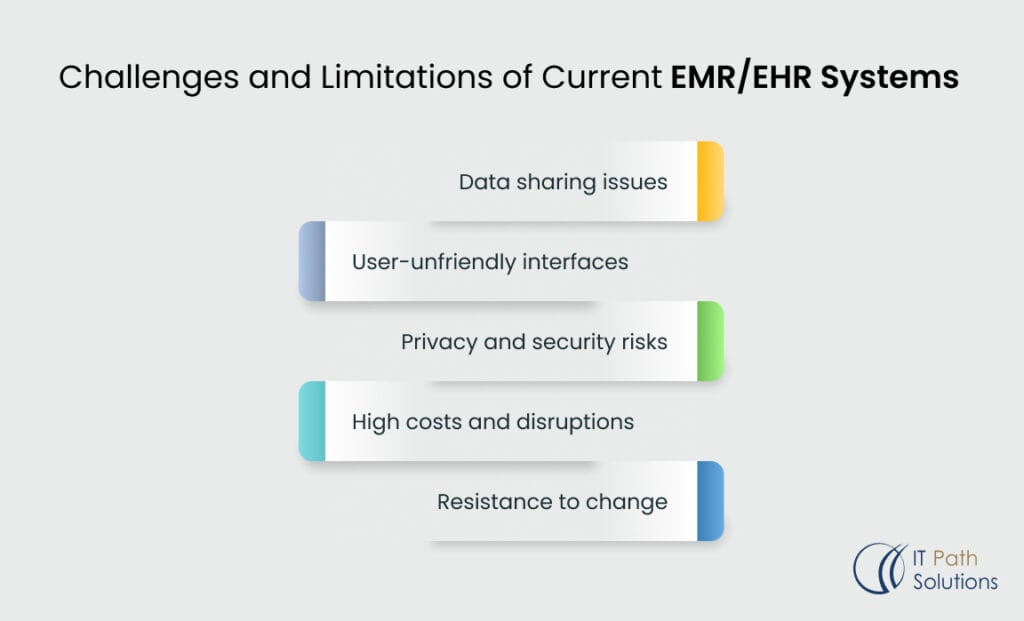
User-unfriendly interfaces:
Many of these healthcare software also remain plagued by outdated user interfaces that seem designed to frustrate and confuse the doctors, nurses, and staff who have to wrestle with them daily. Unintuitive UX means more wasted time, more potential for user error when inputting crucial patient data, and more headaches when trying to find the information you need. And don’t get me started on the struggle of awkwardly retrofitting new EMR System Development into established clinical workflows and processes it was never optimized for.
Privacy and security risks:
With the accelerating digitization of personal health data, privacy and security risks are escalating exponentially too. Serious investments into robust access controls, auditing, encryption, and other safeguards to comply With regulations like HIPAA (Health Insurance Portability and Accountability Act) becoming increasingly costly, and neglecting data protection can lead to severe breaches that compromise patient privacy. There’s no margin for error in this area, as failures can result in significant legal consequences.
High costs and disruptions:
The excessive cost and operational upheaval from deploying these EMR Software Development systems, particularly for smaller healthcare solution providers with limited IT budgets and resources, is another major hurdle. Complex software rollouts inevitably lead to chaos and disruptions as staff fumble with unfamiliar new tools while record migrations are a disastrous minefield waiting to happen if not handled meticulously.
Resistance to change:
That doesn’t even take into account the general reluctance from doctors and nurses who have been using outdated paper records for decades. Getting these healthcare professionals to embrace new Digital Networking tools and change their established workflows in EMR System Development is a challenging task, even if the technology promises to improve efficiency.
In essence, the typical modern EMR system development is a fragmented, user-hostile, costly, inefficient, and disruptive mess hamstrung by a lack of vision, technical debt, and an industry still stuck in the past in many ways. These are the uphill battles any new custom EMR System Development has to overcome.
The Need for Custom Development for a Successful EMR/EHR Software
Tailored workflows
Custom EHR software development tailored to your facility’s precise needs is pretty much mandatory at this point based on what we discussed above. There’s no one-size-fits-all, and attempting to shoehorn a pre-built, off-the-shelf product is just asking for adoption headaches down the road.
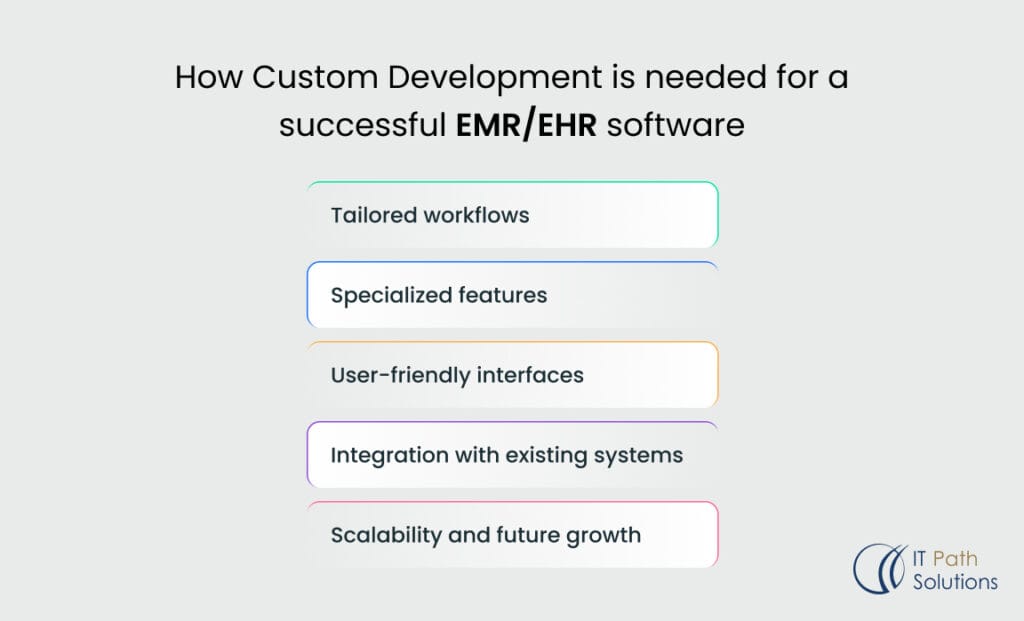
Every hospital, clinic, or practice has its own unique set of internal Clinical Inventory Management processes and operational systems that need to be carefully studied and accommodated. A custom-built EHR/EMR thoughtfully designed around the specifics of how your medical teams work is far more likely to blend seamlessly into existing workflows compared to generic, rigid EHR System Development.
Specialized features
Custom EMR software development allows the features and processes to be precisely molded around existing staff responsibilities, making it a seamless part of established day-to-day routines. That’s a whole lot better than forcefully fitting a system from the top.
Different healthcare specialties and departments like emergency rooms, surgical units, labs, etc. all have their own idiosyncratic needs too. An EHR /EMR system approach enables these bespoke requirements to be codified into specialized tools, modules, and capabilities within the EHR/EMR suite itself rather than forcing ill-fitting one-size-fits-all functionality.
User-friendly interfaces
User experience is also vastly improved through custom UI UX designed to be intuitive user-friendly tailored specifically for the intended staff. This ensures better adoption rates and less frustration compared to generic interfaces that often feel clunky and unfamiliar.
Integration with existing systems
Many healthcare providers already have various other legacy software systems like medical imaging or billing that a new EHR/EMR software needs to integrate with older systems. Custom EHR Software Development allows meticulous integration planning to minimize disruption and facilitate smooth data sharing between old and new platforms.
Scalability and future growth
Crucially, a custom software development company approach provides the agility and flexibility to keep scaling long-term as a healthcare organization evolves and grows over time. Rigid off-the-shelf software products are often quickly outgrown and replaced, whereas a custom solution can receive continuous enhancements and modifications.
What Makes a Winning EHR/EMR Software
Patient Management Portal
At the core of any EHR suite lies a robust patient management portal for handling all the administrative heavy lifting – from initial case registrations, hospital admissions, and transfers to eventual discharges.
When a patient first enters the healthcare cloud system by walking into a facility, detailed registration data like contact information, home addresses, employment records, insurance details, and demographics are collected and inputted at the admission desk. From that point on, a unique medical record number acts as the universal ID for monitoring every single interaction, test result, diagnosis, prescribed medication, and follow-up visit associated with that patient’s care journey.
Medical Records Sections
Having an organized medical records section within the EHR System Development is essential for equipping patient care teams with data-driven insights to make well-informed patient treatment decisions.
This feature serves as the central repository where clinicians can systematically document and review a patient’s comprehensive medical history including physician notes from office visits, hospitalization records, surgical procedures performed, and other key details from the medical records.
Furthermore, this feature is seamlessly integrated with auxiliary systems like pharmacy management to unify important supplementary information like medication lists and nursing notes – all helping paint a more holistic picture of someone’s health background to drive better health outcomes.
Billing and Financial Tracking
Accurately capturing and tracking every billable service performed is crucial for a healthcare facility’s financial performance, productivity metrics, and operational efficiencies.
Beyond just diligently recording all the expenses incurred during a patient’s course of care, robust EHR billing capabilities provide healthcare executives with powerful dashboard visualizations for monitoring a wide range of key business performance indicators. Detailed analytical reports can also be generated by collating multidimensional data across the entire organization.
Armed with this level of sophisticated insight into areas like historical revenue trends, service line profitability breakdowns, and cost drivers, financial leadership can make more strategic decisions for optimizing operations, adjusting growth plans, and identifying new market opportunities.
Digital Prescriptions
The core purpose of digital health monitoring within an EHR Software Development is to provide medical professionals with easily accessible, centralized data for making more informed patient care decisions.
By having full visibility into a complete record covering someone’s health history, allergies, current medications, and more, doctors can make smarter judgment calls when diagnosing patients and prescribing new treatment plans or drug therapies.
e-Prescribing streamlines provider workflows with computerized records solutions, checks for medication errors or allergies, and accelerates fulfillment by electronically routing prescriptions directly to a patient’s preferred pharmacy. In essence, it improves the quality of care and patient safety by eliminating inefficiencies from outdated paper-based prescription management.
e-Prescribing streamlines provider workflows with computerized records solutions, checks for medication errors or allergies and accelerates fulfillment by electronically routing prescriptions directly to a patient’s preferred pharmacy. In essence, it improves quality of care and patient safety by eliminating inefficiencies from outdated paper-based prescription management.
Making Sure that Your EMR/EHR Software is Compliance Ready
Ensuring that your EMR/EHR software meets compliance standards is crucial for protecting patient data and avoiding legal issues. Adherence to regulations like HIPAA not only safeguards patient privacy but also helps maintain the integrity and security of your healthcare system.
Data Protection:
Data protection is paramount, which is why a modern EMR/EHR Software solution needs to be architected from the ground up with robust security capabilities like encryption, granular access controls, and comprehensive audit trails to secure sensitive patient information and mitigate risks of breaches or unauthorized snooping.
Privacy Rules:
Adhering to all relevant privacy regulations like HIPAA is non-negotiable. The software has to have robust controls and processes baked into its core design to ensure complete safeguarding of protected health information (PHI) at all times, including during data transfers or system integration touchpoints.
Documentation:
Comprehensive documentation functionality is a necessity to systematically capture all the required structured data for an individual’s patient records, treatment plans, medication histories, and medical expert’s notes to maintain full legal compliance.
Reporting:
Reporting tools to ensure various regulatory and compliance reporting requirements can be easily met and are important as well. An inability to surface quality metrics, public health disclosures, or auditing information is a major headache in EMR Software Development Solutions.
Audits:
Built-in secure audit trails and access logs that can withstand scrutiny during external audits or compliance checks are critical for demonstrating the system is being properly used according to well-thought-out and established protocol.
Third-Party Integrations:
If an EHR solution needs to integrate with external third-party data sources or software platforms, those connectors must also adhere to the same rigid industry standards and security controls to prevent compliance gaps.
Overcoming Hurdles in Custom EHR/EMR Software Development
Complex Requirements:
Translating an organization’s intricate and often nuanced healthcare processes into functional software requirements is no simple undertaking. Getting granular and accurately mapping each workflow detail is crucial, but complex in reality. Close collaboration with subject matter experts and end-users throughout the development lifecycle by expert healthcare developers is essential in EHR System Development.
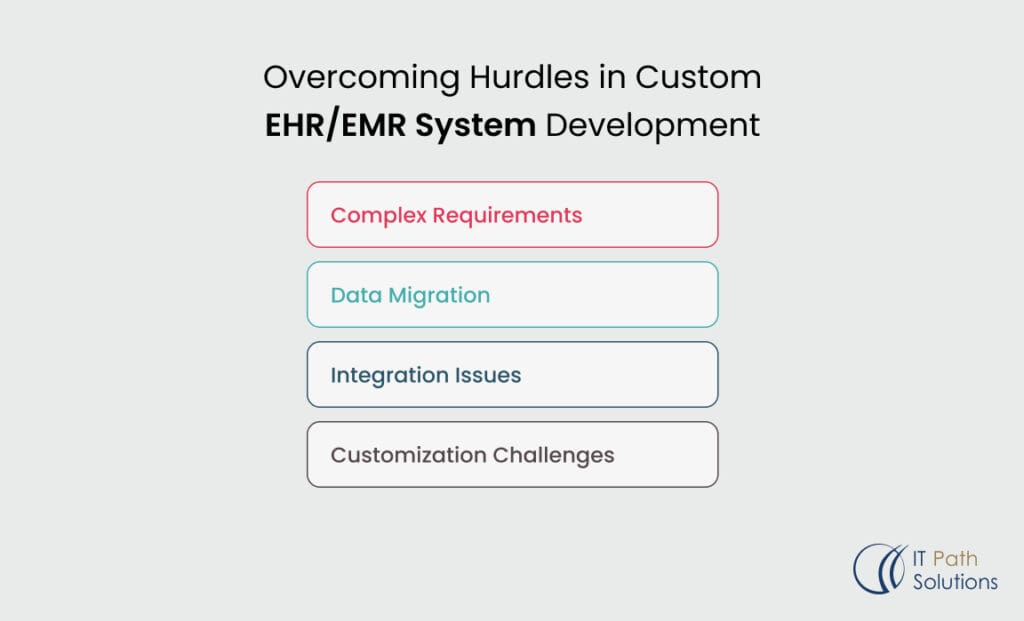
Data Migration:
There’s also the considerable data migration challenge of responsibly extracting and transferring years’ worth of accumulated patient records housed across legacy EHR systems or paper file archives into the new platform. Meticulous data cleaning, validation, and rigorous testing of migration scripts are required to avoid HL7 data integrity issues in EMR Software Development.
Integration Issues:
The new EMR Software Development system may need to integrate with different existing software like billing, lab systems, etc. Identify all integration points early, follow industry standards, and test integrations thoroughly.
Customization Challenges:
Since it’s a custom system, making changes or implementing features later can be difficult in EHR Software Development. Follow best coding practices, have good documentation, and plan for an iterative development approach.
How To Allocate Best Possible Budget and Technology for Custom EMR/EHR
Budget
Developing a custom electronic medical records (EMR) system is going to be a comprehensive effort. I want you to think about what your medical facility needs from this custom EMR System Development. Plan, have a consultation call with the development experts, and have a clear bird s-eye view of the system that is to be designed. Balance out cost and features.
Modern Technology Stack for Building Custom EHR/EMR
Time to turbocharge the technology of the future. I’m talking about architectures that can Handle substantial data loads, pass HIPAA security audits, and potentially support the integration of AI and ML if required.
For the front end, React could be a smart choice to build those EMR interfaces doctors will spend hours accessing for their patients. Throw in some Redux magic for wrangling all those patient data states. Over on the back end, I’m thinking of Node.js and Express to power the servers.
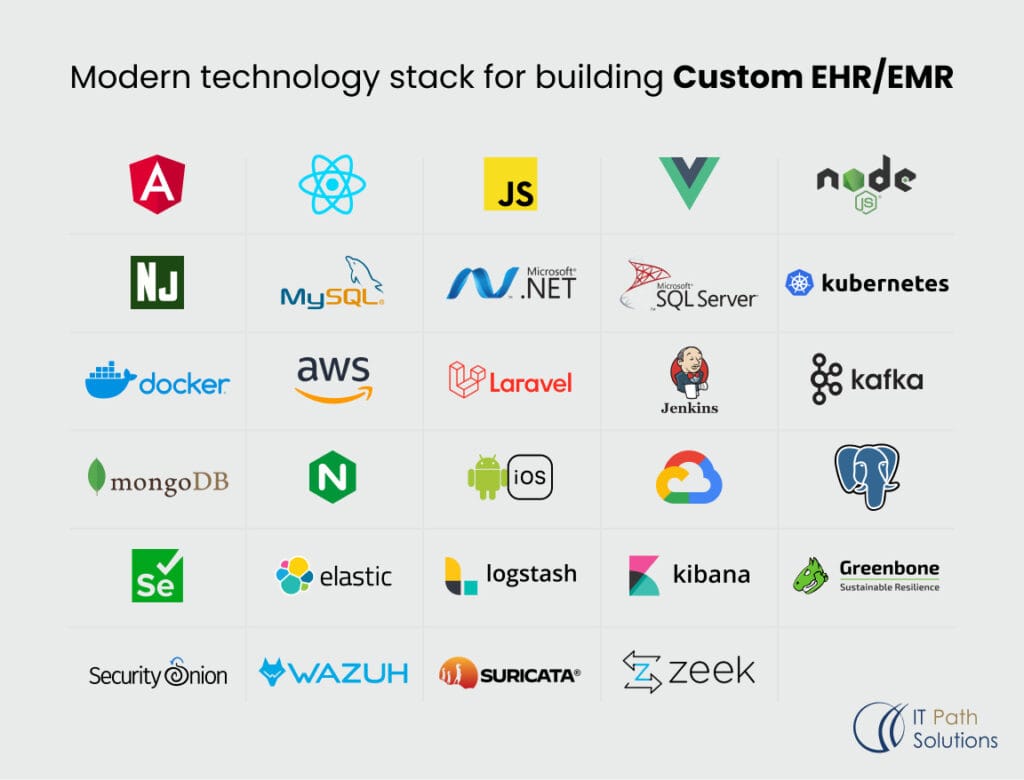
Then you’ll need to make a critical database call: do you go with the NoSQL crowd-pleaser MongoDB? Or stick to the tried-and-tested relational route with something like PostgreSQL for your EHR System Development?
Custom EMR/EHR: What Future Does It Have?
Imagine the future of custom software development in healthcare, where the technology is so intuitive and specialized that entire clinical data transfer workflows are at our fingertips. Interfaces will be sophisticated enough to respond to voice commands, instantly bringing up relevant charts.
AI assistants will analyze data in real-time, alerting healthcare professionals to drug interactions and suggesting optimal treatment plans within EMR systems.
These custom EMRs will not function as isolated silos. Instead, we can expect seamless interoperability in EHR software development, allowing different clinics to share records with a simple click or voice command.
Patients will benefit from sleek mobile health apps that consolidate health data from all their providers, facilitating secure video calls for quick telehealth visits when needed.
Conclusion
By truly investing in tailored medical software that fits your organization’s unique needs, processes, and regulations like HIPAA, you’re not just checking regulatory boxes in EHR System Development. You’re arming your staff with optimized workflows designed to reduce inefficiencies and boost patient care in meaningful ways.
It won’t always be an easy road, with complex requirements, data migration hurdles, and more niche use cases than a circus performer convention. However, stick the landing, and you’ll have a future-proof EMR Software Development system built to grow alongside your healthcare empire.
As tech continuously evolves, these custom EMRs will only get smarter – offering AI-powered clinical decision support, seamless telehealth experiences, and patient self-service portals that’ll make MyChart look like Windows ME. It’ll be medical EHR Software Development revolutionizing how your staff operates.
 Healthcare
Healthcare  Education
Education  Real Estate
Real Estate  Logistic
Logistic  Themes
Themes
 Plugins
Plugins
 Patterns
Patterns


